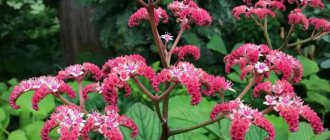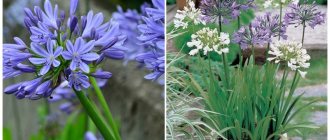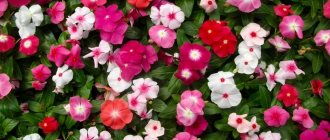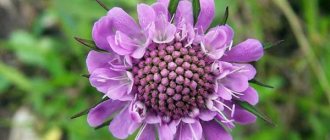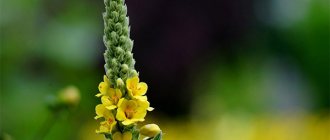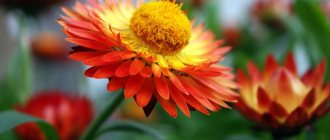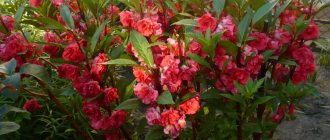Tenacious (Ajuga) are annual and perennial herbaceous plants from the Lamiaceae family. People call it ayuga, gourd, dubrovka, heart grass, dubrovnitsa and bitterweed; it blooms in May, as soon as the snow melts. It grows throughout the entire territory, except the Arctic Circle, preferring moist, shaded forests and rocky soils exposed to the sun. It spreads quickly throughout the territory due to its superficial rhizome.
In Russia, the most common species is the creeping tenacious (Ajuga reptans).
Description of the survivor
Herbaceous plant with two lips, 8 pcs. flowers from blue to white, collected in small inflorescences (spikelets). The corolla has an upper bilobed and a lower three-lobed lip.
The seeds ripen by the end of summer - the third ten days of July. In early August they appear as four bright brown fuzzy nuts. Under unfavorable weather conditions, the tenacious plant becomes a self-pollinating plant, and under favorable weather conditions, it is pollinated by bees.
The stem of this plant is erect, up to 0.5 m in height, has four sides, and can descend. At the bottom there are long oblong leaves, closer to the top they are short, jagged along the edges. The creeping tenacious has creeping shoots characteristic of this species. Over all this time, about 45 varieties of creeping ajuga have been bred (differing from each other in shade, both foliage and flowers).
Gardeners love it very much for its unpretentiousness, preferring to plant it along the fence and in the shade around trees and shrubs, on alpine hills, and also to create a creeping carpet.
Growing conditions and care for survivors
Growing
Despite the fact that the plant is very unpretentious, the ideal soil for planting is well-moistened, humus-rich loam. In summer, it can go up to 4 weeks without watering. During this period, the plant will lose its decorative appearance, but will quickly recover if watering is increased.
Seeds of creeping tenacious have a high germination rate: they can be sown in open ground in spring or autumn, before winter. Vegetative propagation is possible by dividing the rhizome or bush into rosettes.
Creeping tenacious Dixie Chip
Landing
In early spring, after the snow has melted, you can plant young plants. The distance between each outlet should be about 20-30 cm, depending on the type chosen. The plant can survive short-term frosts down to -8...-10 degrees. The growing point is left above the soil surface, watered abundantly during planting and during the first two weeks after it.
Watering
Most varieties prefer abundant watering. It is enough to water an adult plant once a week during the hot season.
Creeping tenacious Arctic Snow
Diseases and pests
Ayuga almost never gets sick, with the exception of fungal diseases. The plant is exposed to this disease extremely rarely, only in very neglected gardens. The only pests of the plant are garden snails and slugs. You can get rid of them by watering the soil with lime mortar or by placing toads in the garden.
Transplantation and propagation
Growing ayuga is easy even for a less experienced gardener. Young plants are planted in well-moistened soil. If the plant grows in one place for more than five years, then it is necessary to apply nitrogen fertilizers and fresh soil.
In March, after the snow has melted, you can reproduce by dividing the rosette. A heavily overgrown plant can be planted from May to September; to do this, it is enough to separate part of the creeping stem with rhizome. The superficial rhizome does not require deep loosening, so caring for the creeping tenacious plant in open ground comes down to periodic watering.
To grow tenacious plants from seeds, it is better to use planting material from the store, since most varieties are hybrids, the daughter plants will not bear all the maternal characteristics.
Creeping tenacious, Geneva, pyramidal and Chios: photo and description
The most popular types of survivors are:
| Type and its characteristics | Varieties and their descriptions | Leaves | Inflorescences |
| Creeping. A ground cover flowering plant. | Metallica Crispa. Shoots crawl along the ground. | Dark brown with a metallic sheen. | Bright blue, terry. |
| Atropurpurea. Loves the sun. Up to 20 cm in height, creeping. It grows on its own and does not require close care. | Dense brick color with a bronze sheen. | Dark blue, growing crowded on the stem. | |
| Burgundy Glow. | Light green, blue, reddish, with pink spots and thin veins. Color depends on soil, feeding and light. The more light, the brighter and redder it is. A lack of microelements will give the effect of pallor. | Burgundy, blue-bluish. | |
| Multicolor. | The color changes depending on the lighting - in the sun it becomes bright purple with thin red or orange stripes, in the shade it becomes a thick green color with pink or yellow streaks. | Blue. | |
| Chocolate chips. It spreads quickly over loamy soils in partial shade and sun, forming a carpet 5 cm high. | Oval, green, small, can be purple (5-6 cm). | Cobalt shade. | |
| Pink elf. Small bush. Blooms for a long time. | Very small. | Pink. | |
| Rainbow. Creeping, very dense appearance without dips. | Spotted yellow to white on a dark green background. Similar to the Multicolor variety, but more saturated. | Lilac. | |
| Arctic fox. Loves sunny places and water. | Ordinary green ones, covered with white streaks (multi-colored lines), under which the color of the leaf itself is not even visible. | Pale blue. | |
| Polar snow (Arcticsnow). | Green corrugated with a large milky spot and whitish edges. (8-10 cm) | White. | |
| Chios. Low-growing up to 20 cm, at the base the stem branches into three, creating creeping shoots. It gets along well on rocky soils, fenced spaces and alpine hills. | No varieties. | Thin green, dark shade with fluff. | Small, yellow with scarlet specks. |
| Geneva or shaggy. Dark green shaggy stem, grows up to 50 cm. There are no creeping shoots. It is successfully used by traditional healers. | Helena. | Narrow, elongated oval. | Lilac. |
| Blue ocean. | Up to 20 cm, thick green, elongated, drooping. | Light blue, with clearly visible adjacent leaves. | |
| Pyramidal. It does not have creeping roots along the ground, is resistant to drought, grows slowly, resembles a pyramid. The stems are fleshy but fragile. Listed in the Red Book. | Metallica Crispa. | Deep dark green in color, oval, jagged along the edges, with white thin lines. | Dense purple color, can be white and pink. |
Application in landscape design
Creeping tenacious is a small plant, grows up to 10-30 cm in height, but with the help of rooted shoots it grows strongly, forming extensive carpets. In cultivation, this feature can be problematic because the plant can quickly drown out other, weaker species, but sometimes it is very desirable when we are looking for a classic ground cover plant for the garden. With its help you can cover empty, shady corners of the garden or use it to cover the ground under trees and shrubs.
In gardens and local areas, there are many options for using tenacity in landscaping:
- In a group planting. The tenacious ones are most beautifully presented planted in groups of several dozen pieces. For an interesting visual effect, it is worth planting many varieties with variegated, multi-colored leaves and flowers nearby.
- ground cover plant. The tenacious plant has fast-growing shoots that take root easily, and in the shortest possible time covers the area with a carpet of multi-colored leaves, so it is well suited for sodding the soil. Depending on the variety, the leaves are dark green, brown, red, red-pink, spotted - they create a pleasant background for blue, white or pink flowers. The leaves are partly evergreen, so the survivors will decorate the garden during mild winters.
- For shady areas . Tenacious plants can grow even in very shady places where other plants cannot grow due to lack of sunlight. They are ideal for planting in the shade of large trees, under bushes. Plants grow well on slopes and any slopes of the area - they have soil strengthening properties and prevent landslides.
- Near bodies of water . Creeping tenacious can be planted near ponds and reservoirs; it tolerates even very wet substrates and works well as an edging for a reservoir. Near the pond she will find appropriate soil moisture and shade.
- In rocky gardens . Looks good on rocky cliffs, where its colorful, partly evergreen leaves create an interesting background. Excellent for decorating stone walls from which shoots hang picturesquely.
- border plant. These perennials are suitable for edging flower beds and paths.
- For pots. The tenacious ones can be grown in large pots and containers - they will decorate a shady terrace or balcony.
- Honey plant . Tenacious plants belong to honey plants, attracting pollinating insects. They bloom for a long time (from May to August), providing bees with pollen and nectar for several months.
If you do not need the ground cover qualities of the tenacious and do not want it to take over the garden, you can limit its growth using root barriers or plant the tenacious in old pots buried in the ground, and you also need to systematically cut off rooting shoots. To limit the growth of the tenacious plant, you can plant it in moist gravel gardens in compositions with other ornamental shade-tolerant plants:
- heuchera;
- hosta;
- ferns;
- brunneroy;
- ivy;
- geranium;
- touchy;
- low ornamental grasses.
Ajuga reptans also has medicinal properties. The infusion has antibacterial, disinfectant, anti-inflammatory and astringent effects, promotes the normal functioning of the heart and cardiovascular system, and the thyroid gland. Has an analgesic and calming effect, relieves persistent cough. Infusions can also be used as compresses for affected areas of the skin. They are also used for conjunctivitis.
Caring for ayuga in the garden
Until new leaves appear, the plant needs to be watered, the soil should be moist, it is better to shade the sprouts so that they are not in direct sunlight. As soon as the plant has taken root and started to grow, water moderately, only when the soil is completely dry.
Due to the superficial creeping roots, the tenacious plant very quickly fills the area. To avoid this, you need to press the plant a little into the ground, you can also fence it off with stones or gravel.
Description of the creeping tenacious plant
The tenacious plant grows everywhere, with the exception of regions with too harsh a climate. But the bulk of the varieties are found in Europe, Asia and Africa.
Grass can grow anywhere, thanks to its frost resistance and unpretentiousness to the composition of the soil.
It is worth noting that this plant is valued by gardeners for these positive qualities and for its long flowering period.
Through the work of scientist-breeders, many varieties of crops have been obtained, with their own differences. Each variety has a different leaf color. In some species it is quite unusual. And just like in the wild, the bush can be grown in any site conditions. Be it the shade of a tree or building or infertile soil.
Tenacious is a common herb that is famous for its medicinal properties. For these qualities, the people have given the survivor such nicknames as “dubrovka”, “ayuga”, “dubrovnitsa”, “gorkusha”, “gorlyanka” and “cordial grass”. But it’s true that culture is used to treat and prevent diseases.
Tenacious is a grass that blooms with two-lipped small flowers, collected in inflorescences similar in shape to a spike. There are varieties with blue, blue, pink, white and yellow flowers.
The bush blooms by the end of spring, and by mid-summer or later the tenacious plant produces seeds. It is worth noting that even after the end of the flowering period, the corolla does not fly away, but remains on the plant. Zhivochka is a self-fertile crop, but is also pollinated by bees. After the ayuga has bloomed, in place of the flowers, peculiar brown nuts with a gray tint - fruits - are formed.
The fleecy shoots of the plant grow straight upward. The length of the stems themselves is 10–50 cm. The foliage extending from the shoot forms rosettes; the leaf plates themselves are not separated by anything and are shaped like an egg; the edge of the leaf is jagged. It is worth noting that the roots of the crop are close to the surface, due to which the grass grows quickly.
Other methods of reproduction
It is recommended to grow ayuga from seeds only if it is first grown in a garden plot. The tenacious plant can reproduce by self-sowing, and the grown specimens differ from the mother plant in the color of leaves and flowers; this also applies to seeds planted by hand.
To prevent the appearance of “other” species of this plant, you should cut off the arrow of exclusively deciduous plants, a tenacious plant that delights with different shades of inflorescences when they fade.
If you want to get a completely identical plant, then at the end of May or before the 20th of September it must be propagated by rosettes (this term refers to low-growing plants whose leaves are crowded to the root), replanting them in a new place. As soon as the plant takes root and begins to grow, they stop watering it.
The tenacious plant does not like damp soil and adapts well to arid lands.
Botanical description
Depending on the species, the tenacious plant can be an annual or perennial. It reaches a height of 5-50 cm. The stems are erect, ascending or creeping.
The basal leaves are large, overwintering, and located on long petioles. The stem plates are smaller and not densely located, almost close to the shoots.
The corollas of flowers can be yellow, blue, light blue, violet. Breeders have also bred decorative varieties of this plant. They may have snow-white or pink petals. The buds are collected in spike-shaped inflorescences and grow densely along the entire stem. You can see what it looks like in the photo of the survivor.
After flowering
It is impractical to collect seeds; it is possible to prevent self-seeding, but it is troublesome; different plants (that do not correspond to the mother specimen) spread very quickly on the site. For the same reason, you should not collect seeds manually, which is why many gardeners propagate the tenacious plant with rosettes.
This plant can easily survive a snowy winter, but if there is not enough snow, it is better to cover it with spruce branches, peat, and dead wood. Young plants must be covered for at least the first year.
Reproduction
Tenacious can be propagated in different ways.
Seeds
Breeding in this way is not the best option; it is only suitable for those who are just starting to live and do not have adult bushes to obtain rosettes. If there are such plants, and you still decide to take ripe seeds from them, be prepared for an unexpected result. The ayugas obtained from them are unlikely to correspond to the description of the variety.
Vegetatively
Breeding in this way should be left until March or the first quarter of September. The rosettes that have managed to appear on the mother plant are cut off and planted in the place where they will grow permanently. You can get a lot of new bushes, because it doesn’t matter whether the cuttings have thick roots, you can also take those with one root.
Diseases and pests
| Name | Signs | Elimination methods |
| Fungal rot | When there is excess water, the roots and stems are affected by gray rot. As a result, the tenacious plant stops growing, blooming and producing new rosettes. | Immediately remove the affected stems and leaves; treat the remaining ones with Rovral, Kuproskat, Fundazol, Copper sulfate or Bordeaux mixture. If the root is affected, remove it too and treat the remaining root with crushed activated carbon or ash. |
| Slugs and snails | They eat the stem and leaves. | If a large concentration of slugs is found on the ayuga, the first drugs that need to be used are Meta and Thunderstorm. In addition, you can sprinkle with homemade mustard solution (250 g of mustard per 10 liters of water) or crushed pepper. In the fight against slugs, there is another method - deepen plastic cups into the ground next to the plant, filling them a little with beer or milk; in the morning you can find a catch of slugs in these cups. |
How to plant a survivor correctly
To plant ayuga at home, you do not need any special skills. This plant is so unpretentious and tenacious that no matter how inept you are in gardening, it will still germinate.
- Creeping tenacious grows well both in full shade and in light (but still try to avoid areas with direct sunlight). It will grow well under bushes.
- She feels good on any soil, but prefers loam and sandy loam.
Planting and propagation of ayuga (video)
- Requires at least a minimum amount of precipitation. Can tolerate drought for a month. But it is necessary to water newly planted seedlings or seeds for at least the first week. At first they need good care.
- Do not plant the survivor in places where animals may be walked on or walked on it. This plant is very sensitive to mechanical stress. The fragility of the stems is noticeable even in the photo.
Medicinal properties of tenacious
The composition of the tenacious has been studied rather poorly; it is known that it contains tannins. A decoction of this plant, as well as juice, is widely used to treat:
- For gastrointestinal diseases (stomach ulcer and gastritis), crushed leaves are brewed with boiling water in a glass, left for 2 hours, poured into a thermos or wrapped in a warm scarf, then drunk warm, 1 tbsp. l. three times a day.
- Female organs and genitourinary system, as an analgesic and expectorant, also for malaria. Use the decoction given above, but take it 5 times a day, also drink warm.
- For colds, brew creeping tenacious, linden flowers, lemon balm and oregano, all in equal quantities. Drink warm several times a day, the mixture causes increased sweating, which removes harmful substances and reduces temperature.
- If your hair grows poorly, you should rinse it with ayuge decoction more often.
- Healing wounds or bites. Make a paste from a freshly picked leaf and apply it to the site of a bee or other insect bite, as well as to a non-healing wound.
- For anorexia (painful thinness), take a bath at night, adding herbal tincture to the water.
The best partner plants for survivors
The best partner plants for survivors are the following.
Loosestrife "Aurea"
These two creeping plants seem designed to grow as a duo. The tenacious and loosestrife become an ideal pair not only because they have a similar growth pattern, but also due to their complementary coloration. Almost all varieties of tenacious have burgundy shades; they are in perfect harmony with the bright yellow foliage of the loosestrife "Aurea". The size of their leaf blades does not differ too much from each other, the speed of spread is also approximately the same, which means that the plants do not shade or clog each other and grow well together.
In addition, the loosestrife "Aurea", like the tenacious one, also requires a sunny place and sufficient watering. The duo of coin loosestrife and tenacious “Burgundy Glow” has been growing on my site for many years, and it is impossible to take my eyes off this bright couple. The duo begins to decorate the garden in spring and continues until late autumn, and when tenacious and loosestrife alternately bloom, this spectacular rug acquires new shades and accents.
Monetary loosestrife and tenacious plants seem to be created to grow as a duet. © Lyudmila Svetlitskaya
Khosta
Tenacious varieties that can remain showy in partial shade can serve as good partners for hostas. Of course, with very massive and fast-growing varieties of hosta, such a proximity will be short-lived, and the survivor will have to get out from under the powerful foliage in order to get at least a little sunlight. But there are a considerable number of hosta varieties that grow relatively slowly. Some of them also have long petioles and not too large leaves.
Thus, the ground under the hostas, until they grow densely enough, may remain bare for several years and require mulching. The tenacious plant can serve as a similar living mulch for the hosta. Aesthetically, hosta and tenacious are also an excellent pair - after all, the small foliage of one contrasts very effectively with the large leaf plates of the other.
Their coloring also seems to be made for each other. Hostas that are plain green or have white or gold patterns go well with the purple color of the hostas. To achieve a quick effect, it is better to add the most vigorously growing and shade-tolerant “Atropurpurea” to the hosts.
Hostas that are plain green or have white or gold patterns go well with the purple color of the hostas. © Lyudmila Svetlitskaya
sedum
By combining different types and varieties of ground cover sedums and tenacious, you can create a real living carpet, the likes of which cannot be found. As they grow, dividing the territory and intertwining with each other, the plants will create unprecedented patterns, striking with the play of their shades and textures.
Almost any creeping sedum will look impressive together with tenacious, but sedums with bluish foliage (sedum eversa) form especially harmonious combinations with tenacious. It is better to plant monochromatic sedums, blue or green, for variegated varieties of tenacious, for example, false sedum. And for single-color survivors, they select two or three colored ones (“Tricolor”) or those with bright red foliage.
The only nuance of this duet is different requirements for the level of humidity, so in the absence of precipitation, the survivor must be watered, but not flooded, so as not to harm the sedum, which, as is known, is a succulent.
Almost any creeping sedum will look impressive together with the tenacious plant. © Lyudmila Svetlitskaya
Conifers
Dwarf varieties of conifers or seedlings of tall conifers at a young age are very miniature in size and need partners that could effectively shade them, but without shading or suppressing their growth. If you plant a tenacious plant next to medium-sized coniferous plants, it will become a wonderful background for their green, golden or bluish needles. Such a living carpet will prevent the formation of soil crust and inhibit the growth of weeds.
From the point of view of landscape design, tenacity will serve as a successful unifying element between medium-sized conifers, which at a young age may look somewhat scattered, and will create the effect of a complete composition. The tenacious plant will look best together with varieties of spherical, columnar and conical shapes, but creeping coniferous cultivars can obscure the mat of tenacious plant.
The survivor is good with young conifers. © Lyudmila Svetlitskaya
Small-bulbous
Most early-flowering small-bulbous plants (scillas, crocuses, pushkinias, dwarf tulips and many others) do not require annual digging, so you can select companions for them from perennial plants.
If you plant a mat of tenacious plantings on top of the small bulbous plantings, then in early spring it will become an excellent background for these beautifully flowering plants, and after flowering, the fading leaves of the bulbous plants can be disguised under its foliage. In May, the survivor will decorate this flower corner with her flowers, and throughout the entire season you can admire its brightly colored foliage. Thus, the planting site for spring-flowering bulbs will remain consistently decorative.
Beneficial features
The plant has beneficial qualities and is used as a folk remedy. It has:
- hemostatic;
- bactericidal;
- sweatshop;
- expectorant;
- diuretic;
- astringent;
- wound healing;
- anti-inflammatory effect.
With the help of fresh juice, survivors treat burns; it destroys germs and bacteria.
The stem and leaves of the crop are used for herbal medicine. Its juice contains ascorbic acid, vitamin K, flavonoids, steroids, tannins and essential oil.
What does the creeping tenacious look like, what family does it belong to?
Creeping tenacious or ajuga (Ajuga Reptans) is a ground cover primrose, creeping perennial herbaceous plant of the Lamiaceae or Lamiaceae family.
Decorative vitality in its foliage
The tenacious plant has the ability to survive light frosts and produces a large number of side shoots. Thin stems look like strawberry mustaches. It has several apical rosettes, which easily cling to the ground cover layer, thereby multiplying. Over time, the tenacious plant fills large spaces on the soil, making it seem like a carpet.
The root system is fibrous. The leaves are light green, ovate-lanceolate, with a carved or smooth edge.
Interesting! Tenacious flowers do not deserve as much attention as the foliage and stem part. They are inconspicuous, small, located on a long peduncle. The arrangement is whorled, resembling a spikelet. Colors from dark blue to light blue.
Tenacious is widespread in all countries. Perhaps it does not grow only at the North Pole. A lover of wet meadows and forests, she can easily tolerate dry places, rocky slopes, and hills.
The plant is valued by gardeners for its ground cover abilities, which is why it is used in landscape design for the design of alpine slides. In addition, the flower is actively used by traditional healers. Ayuga has:
- bactericidal property;
- anti-inflammatory;
- hemostatic and blood purifying;
- diuretic and diaphoretic;
- antiseptic and wound healing.
Thanks to these features of the chemical composition, tenacity helps with some diseases:
- pulmonary tuberculosis;
- bloody diarrhea;
- inflammation of the uterus;
- stomach ulcer;
- colds and flu;
- bronchitis.
The plant can be used externally for rinsing for sore throats, wrapping for burns and frostbite, for cosmetic purposes for skin and hair, and for purulent wounds.
Lively Burgundy Glow
Features of home care
Growing and caring for them in an apartment is different than for plants that grow in open ground. Therefore, below we will describe in more detail how to plant and care for the tenacious creeping house creeper.
Watering
Pyrethrum maiden - growing from seeds
Before new leaves appear on the seedlings, watering is carried out so that the soil does not have time to dry out. When the plant begins to grow in length, watering is reduced to a minimum. It is watered only when the soil is completely dry.
Spraying
The plant in question is completely unpretentious in care, so no additional spraying is required.
Humidity
This plant is preferable to grow in conditions of moderate humidity. If there is excess moisture, it can get sick.
Priming
In order for the survivor to take root, it is necessary to use loose and moist soil. Loose, fertile soil that allows air to pass through is most suitable. The best option is to mix turf soil, sand, peat, humus.
Important! Before planting a flower, loosening additives, as well as drainage and organic fertilizers are mixed with heavy soil.
Feeding
Wood ash is the most suitable fertilizer. Organic fertilizers are also suitable for ayuga. The more you add, the better it will be. Compost and peat are used. Dry fertilizer is poured both under the root and diluted in water to irrigate the leaves.
Mineral fertilizers are applied at certain intervals. For this purpose, complex phosphorus-potassium species are used. In addition, wood ash is used.
Planting by seeds
At home, the tenacious plant is propagated vegetatively by separating the rosettes. The seed method is mainly used in breeding for breeding varieties. In your own garden, you can still grow a flower from seeds if there were none before, but they must be purchased. Store-bought seeds have better germination than hand-collected ones.
The peculiarity of seed cultivation in open ground is that if you independently collect planting material in the future, the varietal characteristics of the mother plant will not be preserved. The newly grown plant will look like a wild plant with no foliage color palette.
Sowing begins in the spring, after the soil has completely warmed up, or in late autumn. The location chosen is the trunk circles of fruit trees. Under them, the seeds will be well preserved until next year and will not die from severe frosts.
Purchased tenacious seeds do not require treatment with growth stimulants. They are directly sown in prepared beds. If the soil in the garden bed is depleted, then sand, peat and rotted manure should be added in equal parts.
Basic rules to follow when sowing:
- Planting depth is 2-3 cm.
- The distance between adjacent achenes is 8-10 cm.
- The distance between adjacent rows is 10-15 cm.
After the emergence of seedlings, carefully monitor the condition of the bed. Weed in a timely manner so that weeds do not draw nutrients. As the soil dries, the beds are watered, and in dry weather, additionally irrigated in the morning and evening. They must be covered for the winter, as young shoots die.
Transfer
Zhivuchka should grow in one place for no more than five years. Afterwards it should be updated by transplanting new rosettes or dividing rhizomes. The aerial roots of the stem part are small, so it is enough to sprinkle them with soil in a new place. Further care consists of regular watering and removing weeds.
Separation of lateral offspring for reproduction
When and how does it bloom
The tenacious flower has the following structure:
- inflorescence – spike;
- type of flowers - two-lipped;
- location - in the axils of the leaves, collected in 6-8 pieces;
- cup length – 7 mm;
- corolla shape – bell-shaped;
- upper petals – short two-lobed lip;
- lower petals – long three-lobed lip;
- corolla length – up to 17 mm;
- completely pubescent on the outside;
- color: blue, light blue, shades of purple, pink, cream, yellow.
After flowering, the petals do not fall off, but remain with the fruit, but in a dried form.
Important! Flowering begins in early May and continues until the end of June. There are species and varieties with a longer flowering period.
Tenacious flowers are not decorative, so special care is not required during flowering. Some gardeners deliberately cut off the flower stalks to make the carpet look more elegant, and cutting off the inflorescences is also required during the ripening of the seed pods so that the tenacity does not thicken and become obsolete.
What does a tenacious flower look like?
